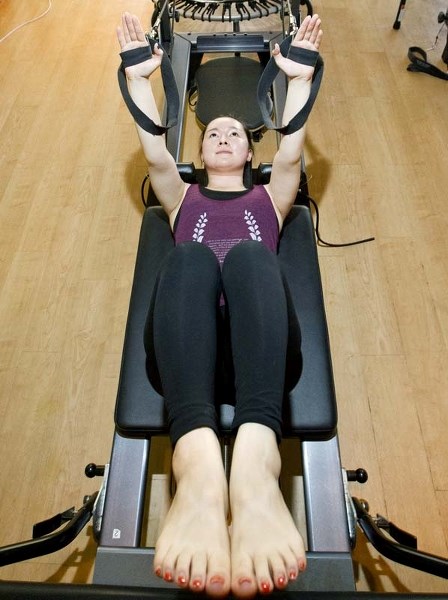My head is fastened between two pieces of hard foam while my legs are splayed above my head in straps.
On one hand I feel as if I’m in the circus, a trapeze artist ready to launch myself onto the next bar, my legs the only things keeping me from crashing to the ground.
On the other hand this strange body contortion takes me back to my university days – as a volunteer guinea pig for graduate psychology students I was strapped into a pseudo hospital bed on several occasions.
However this experience was much more pleasant than either of those; instead it was my first go with the Pilates Reformer.
Upon first glance the Pilates Reformer machine is reminiscent of the rack – a medieval torture device – because of its various springs, ropes and pulleys. Fortunately, no limbs were dislocated during my one-hour session with trainer Kathy Giesbrecht at Sturgeon Valley Athletic Club; instead I got a good workout.
Pilates is an exercise regimen developed by German born Joseph Pilates during the Second World War. While in an internment camp, he devised rehabilitation exercises using bedsprings and beer keg rings for injured detainees.
Widely known as a series of floor exercises, Pilates has evolved to include other pieces of equipment such as the reformer, the chair and the barrel, to further increase muscle strength and flexibility. The Pilates method gained popularity in the 1980s with celebrity devotees including Gwyneth Paltrow and Denise Richards.
The Pilates Reformer consists of a sliding platform with springs on one end that can be adjusted for resistance. One can either lie down, sit, stand or kneel on the platform and complete exercises by pulling on the ropes (attached to hands or feet) or push off from the stationary foot bar.
One of the objectives of the Reformer is to provide guided resistance training using the tension of the springs and your own body weight. The type of resistance is supposed to reduce stress on the body’s tendons and the ligaments and help correct muscular-skeletal imbalances.
On the Reformer I tried working out several muscle groups, first by stretching out my hamstrings and calves by flexing my heels and then toes on the stationary bar.
Once I got the hang of that, next were deltoids. With my back flat on the platform, my hands slid into the straps while my bent knees were up at 90 degrees perpendicular to my body.
Pulling my arms down to my sides, I could immediately feel muscle toning in my deltoids and biceps just after a few reps. But the form of my arms wasn’t the only thing I had to think about, I also needed to keep my spine flat and my abdominals engaged to keep my legs up and in the right position.
“It’s probably one of the best exercises because you’re really focusing on what you’re doing,” said Giesbrecht. “It’s intelligent exercise.”
Even though the exercises are done on a machine, the Reformer still follows the basic tenets of Pilates including spine and pelvic placement, breathing and core stability.
“I think the reformer is now what most people are wanting,” added Giesbrecht, referring to the surge of clients taking to the Pilates Reformer over the past several years. She noted her clients range from the young to old, from “boot camp type” exercisers to those suffering from chronic disease such as Lou Gehrig’s disease.
“People want to exercise – get stronger, increase their flexibility and core – while doing it safely,” she said.
My first taste of the Pilates Reformer workout was eye-opening, it challenged me to think about and feel muscles that I didn’t know existed. I felt I had to adopt a different philosophy of working out – based on concentration and precision rather than speed and endurance – in order to be successful at it.
The method has definitely perked my interest and I can see how it would be beneficial for people who have limited mobility and those interested in the mind-body connection in exercise.
Giesbrecht advises people that are interested in the Pilates Reformer to start off with a one-on-one sessions before group classes in order to get used to the machine.
Gazette reporter Amy Crofts will try a different workout each month in an attempt to inspire people to start their fitness New Year’s resolutions early, rather than just in January. If you have a workout idea, e-mail: [email protected].




